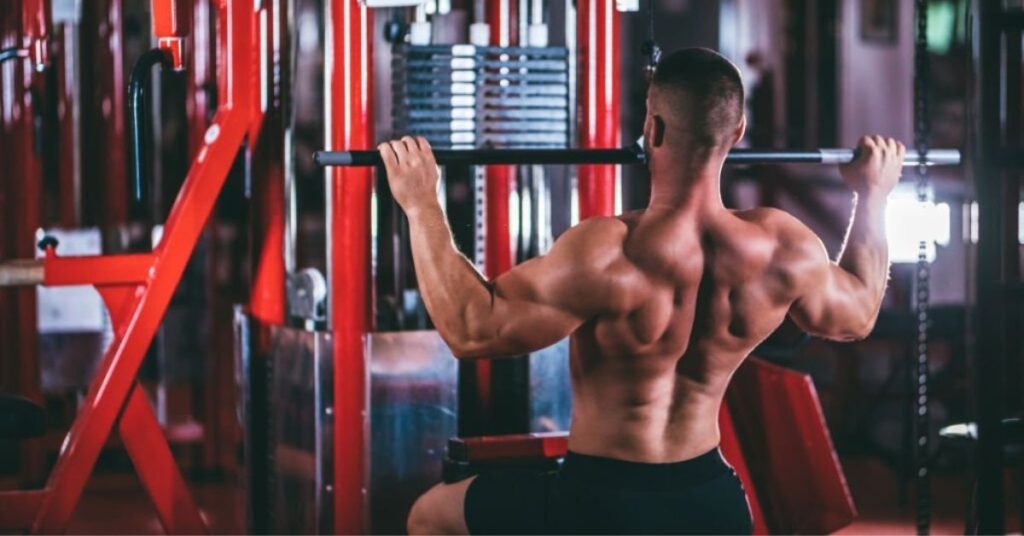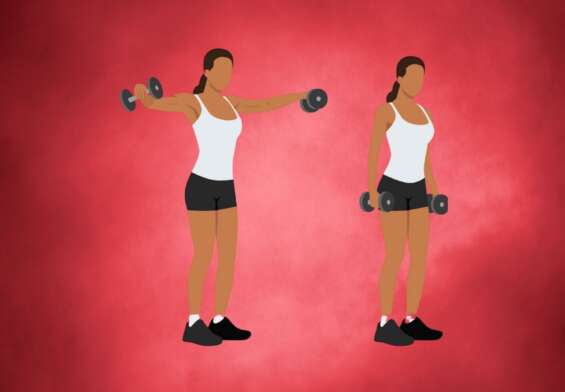
The Best 7 Front Delts Exercises For Bigger Shoulders!
The deltoid muscles in your shoulder are divided into three main fibers the anterior (front), the posterior (front) (middle), and the posterior (rear) deltoid muscle.
Three parts of the deltoid work in concert to support the shoulder joint and allow the arms to move in a variety of directions.
The front delts are specifically activated to help you flex your upper arms that raise your arms upwards and in the direction of your physique.
The anterior deltoids assist in abduction of the shoulder, which allows your arms to move upwards and down to the side.
Benefits Of The Front Delt Exercises
Training exercises that specifically target your front delts can be highly useful.
The front delts’ training should be given priority for these reasons:
#1 Reduced Risk Of Injury
Because your shoulders move freely in various directions, they are more prone to injury than other joints.
To that end, strengthening your front deltoids will help stabilize your shoulders.
The shoulder muscles you train can give you extra support to avoid injuries that could keep you from moving for months.
#2 Stronger Shoulders
The front delt exercises are designed to tear the muscle fibers of your shoulder and boost the anterior delt’s hypertrophy.
You’ll build larger shoulders that will increase your performance when doing compound exercises, such as the overhead press or the inclined dumbbell press.
Your front delts serve as the primary movement in various pushing exercises. You should work them in the right way.
#3 Improved Aesthetics
If you’re exercising to improve your appearance, you need to put your shoulders first.
Many people are prone to overwork their chests, leaving them with proportionally smaller deltoids.
Although many push exercises work the front delts, these exercises are specifically targeted at the front delts to help build broader shoulders.
Not only are large shoulders attractive and attractive, but it’s generally safer to boost the development of your muscles in a balanced way. Torso.
Let’s look at the top front delts exercises!
7 Powerful Front Delts Exercises
#1 Dumbbell Front Raise
This is among the best exercises for front delts for different fitness levels. Take a dumbbell and give it a go!
Setup
- Assume a relaxed stance while standing and keep your spine straight.
- Take your dumbbells with your palms facing your direction.
Instructions
- Engage your front deltoids to lift the dumbbells ahead of you. Stop just above your forehead.
- Take a break before slowly returning to the beginning position.
- Repeat!
#2 Angled Downward Push Up
Do you have no weights? It’s not a problem! This exercise using front delts with body weight can be as vigorous as shoulder exercises that are weighted.
Setup
- Place your hands together on the ground, with your fingers facing one another.
- Retract your feet and raise your head in the air. The head should rest straight in front of your fingers.
Instructions
- Flex your elbows towards the sides, then lower your head towards the ground.
- Take a break and then contract your front delts to push you back into the starting position.
- Repeat!
#3 Half Kneeling Landmine Press
Landmine presses that you kneel on are among the most effective exercises to overwork your deltoids.
Setup
- Place the barbell on an attachment for a landmine in a corner. Still, you could also secure the barbell’s end on the bar with the ground directly in your direction.
- Assume a half-kneeling position, with your back straight ahead of the barbell. Your leading foot should be in the opposite direction to the shoulder that you are working.
- Grab the barbell’s bottom by putting your palms away from you. Bring it up to your shoulder.
Instructions
- Contract your front deltoid to push the barbell upwards.
- squeeze your deltoid with force at the top, then slowly return to the beginning position.
- Maintain tightness in your shoulder, and repeat this motion.
#4 Barbell Overhead Press
The overhead press is a crucial exercise for the shoulder that trains your middle and front delts.
Setup
- Take the barbell with an overhand grip that is doubled with your fingers slightly larger than shoulder width.
- Carefully lift the barbell upwards and place it in your front delts. Involve your core.
Instructions
- Keep your lower body in a still position. Your deltoids contracted; move your upper body upwards until you have locked your arms and the barbell is raised above your shoulders.
- Slowly return the barbell slowly back to the position it was in before.
- Keep your core tight in your core, and repeat!
#5 Dumbbell Arnold Press
This exercise for the front delt is an excellent option to add variety to your shoulder workout.
Setup
- Make sure you are comfortable standing up.
- Take the dumbbells and hold them while bent with both arms with your palms facing the inside like you were on the high point of your curl.
Instructions
- Then, contract your front delts, pressing your arms upwards while twisting your hands until your palms face outwards.
- Squeeze your delts to the highest point of the rep. Then slowly return to your starting position.
- Repeat!
#6 1-Arm Kettlebell Front Raise
The practice of deltoids in isolation will help reduce the muscular imbalances in the shoulders.
Setup
- Assume a relaxed stance while standing while keeping your body straight.
- Take your kettlebell with your palm facing yours.
Instructions
- Then, contract your front deltoid muscles to raise the kettlebell up in front of you, stopping at the level of your forehead.
- Stop for a few seconds before slowly returning to the beginning position.
- Repeat the process, and you are at ease to change sides!
#7 Resistance Band Front To Lateral Raise
This front delt workout relies on the use of time under tension to tear down the muscle fibers of your middle and front delts.
Setup
- Make sure you sit comfortably on a resistance band, keeping an upright back.
- Take the handles in your palms facing downwards.
Instructions
- Reach your arms straight and extend the handles towards the front.
- You should pull your handles away until they’re aligned with your shoulders towards the side.
- Return slowly to your starting point and repeat the motion!
Why Should I Train Front Delts?
The issue isn’t whether you exercise your front delts or not. Rather, should you perform isolated exercises that focus on the front delts since it is obvious that you should train those delts in the front? You don’t train the front delts is the same as not exercising every other muscle.
This question is asked because the front delts are the primary operator during overhead presses. They are particularly activated when you bench press (especially the incline press), which any decent training program should include. This is the same for handstands, push-ups, and pike push-ups for those who do the bodyweight exercise.
Are these exercises sufficient for the full development of your front delts, or do you need to exercise more in isolation?
The answer is yes; it all depends…
How Often Do You Need To Train Front Delts?
If you are unsure when you should be training your front deltoids, it is important to be aware of the quantity and frequency each week.
Ideally, you’ll want to get your front delts working with about 10-12 sets per week, broken into three or four sessions. The number of sets might require more for more advanced trainers and advanced athletes, with around 10-15 sets each week.
Many would suggest that front delts heal more slowly. So, if you would like to train them directly, you should try to train them two times per week, or a minimum 3x per week, with the rest of the time being 48-hours between training sessions that focus on the front delts.
Remember that the front delts train with chest exercises. So if you perform too many exercises directly to the front of your delts, you could begin to harm your chest training.
A typical illustration of 12 consecutive sets over a week could be:
- Day of shoulder Overhead Press x 3 sets, Arnold Press x 3 sets, front Raises x 3 sets
- Chest day Incline Bench Press x 3 sets
- If you did that, you’d get twelve front delts sets directly.
This should be enough for the majority of trainees.
It’s important to remember that in reality, the front delts are stimulated more than this, as they will also be stimulated by the flat bench, push-ups, flys, and other shoulder exercises in a smaller amount.
Front Delt Exercises: Sets & Reps

The number of reps you need to be doing is not a factor without considering the load. Therefore, when you discuss one of them, discuss the other.
To comprehend the most effective rep and load plan, one must be aware of the fibers that make up the anterior deltoids.
The anterior deltoids consist of an even proportion of fast and slow muscles.
In the simplest sense, they’ll react more favorably to a heavier weight for light to medium reps (i.e., 3-10 reps). However, using a lighter weight for higher repetitions (10-15 reps) can be effective too.
The weight should test you (bring you close to failure or even near failure) within the specified rep intervals.
As we’ve learned, overhead presses, incline presses, and front lifts are among the best exercises to work the front delts. So let’s examine these about load and reps.
Incline press and overhead press are best to build strength in your anterior delts. They work best within the 3-12 rep range. 3 to 6 reps with heavyweight, and 6-12 with mediumly heavier weight.
Front raises are usually effective when performed with moderate or lightweight in moderate-to-high repetitions, 8-15 reps. The difficulty of a raise is to reach a true failure. That is, you can’t do another rep. This is because it’s simple to cheat. You want to select a weight that can give you the “burn” during the last few reps and maintain good form.
Remember that good technique is crucial when lifting and pressing to ensure that you are working the front delts instead of compensating (cheating) by using the force of your movements or using other muscles.
What Is The Purpose Of The Anorior Deltoid?
As with all three heads of deltoid muscles, The anterior fibers aid in creating shoulder abduction, which means that your arm is moved away from the body. But, the anterior deltoids’ primary function is shoulder extension (bringing your arm upwards and down) and its medial (internal) movement.
It is important to examine the pec major when discussing the anterior delts. Here’s why…
Your front deltoids and the upper the pectoralis main (clavicular Head) are similar to your near neighbors or, better still, roommates. They both connect on the clavicular (collar bone) and are inserted into the upper side of your Humerus (upper arm bone). If not connected to the cephalic nerve, it would be difficult to determine where the pec major’s ends and where the front delt starts.
This is because your pec major muscles cooperate to stabilize and power various movements and exercises.
They share a significant role, that is, at the same time, shoulder extension (bringing your arm upwards and down, i.e., presses) and internal rotation (bringing your arm inside, i.e., flys).
Most pec-related exercises or movements are also front delt and vice the reverse.
The major pec muscle is the most suitable for taking charge of shoulder flexion when you are higher toward the side (i.e., the wide-grip bench press). In contrast, your front and delts should take control whenever your arms tend to be near your sides or your overhead.
Why So Many Variants?
As you will observe, we have an abundance of exercises that focus on those delts in the front.
We’ve provided the exercises in these categories to help you with the following
You can experiment Start with a handful of exercises for a while but try switching them when you lose interest or see diminishing results. As you advance in your skills, the variety of options becomes more essential.
If you’re experiencing shoulder problems You’ll discover certain exercises easier for your shoulder joint than other exercises. It’s best to find a suitable exercise for you instead of skipping the muscle group altogether. Sometimes, a simple adjustment of an angle or even the equipment you’re using could be the answer. In the end, you’ll be able to rebuild your strength in this manner and eventually eliminate the pain completely (note that if you’re experiencing issues, you should always seek the advice of a doctor or physical therapist before you start).
To allow you to work the front delts, no matter where you are. These exercises require various equipment or nothing whatsoever, which means that regardless of where you are (gym or home, on vacation, or whatever), you will be able to perform a powerful shoulder workout.
Are Your Front Delts Appear Weak, Or Overdeveloped?

If this scenario is true, the isolation exercises following the large pressing exercises could give you the energy boost they require.
If that’s the case, it’s probably best not to bother with isolation exercises for the front delts; instead, focus on the larger compound presses and start doing more back and middle delt exercises.
Note The main reason people perform front isolation exercises for the delt is to increase hypertrophy (aesthetics and definition), and general strength needs to be maintained by the large press movements.
Let’s look at this a bit more since it’s difficult to determine whether your front delts are in weak condition…
Are Your Front Delts Weak?
Many people ask whether their front delts might be weak. Their shoulders are aching before their chests on bench presses or lack strength for exercises like overhead presses.
Here’s the truth the vast majority of those working out for a long time doesn’t suffer from weak deltoid muscles. The front delts get activated with every press, including shoulder and chest presses.
The reality is that the low (imbalanced) front delts are far more common because rear delts are a lot harder to focus on. The same goes for middle delts.
Since the front delts are already being activated efficiently when doing chest presses or overhead presses, most people should focus on the sides, rear deltas, and front delts. It is essential to have an appropriate balance of deltoid exercises.
Many would argue that front-delta focused isolation exercises are unnecessary, as you perform large compound pressing movements.
But, adding a front delt isolation routine to your workout routine and the large press exercises shouldn’t be a problem as you ensure that your front delts don’t seem overactive.
Be aware that if you feel that your front delts feel weak when you press, It could be that they’re undertrained. Consider this if you have a split that has chest and shoulder days, your front delts might not have had enough time to recover between sessions. It’s also probable that your front delts are exhausted easily because the weekly amount of work done by your front delts is too much. They aren’t weak due to insufficient training…OR the possibility is because your front delts are too active …
Are Your Front Delts Overdeveloped?
Besides poor frontal delts specifically for intermediates to late-beginners, the most common issue is the overactive front delts. This means that the front delts dominate exercises such as the flat bench press making them feel like they’re aching before the pecs.
The best thing to do is to concentrate on good technique (shoulder blades extended and minimizing the movement of your shoulders when benching) or experiment with different grips for bench press which are more effective at focusing on those pecs (i.e., wide grip flat bench).
One of the biggest issues with front delts that are overactive is that it’s difficult to overwork your pecs enough because your front delts will be dominating the bench (or pushing ups).
Furthermore, overactive front delts can lead to a hunched position (rounded shoulders) because of tightness. This leads to many issues, including chronic pain in the rotator cuff.
If your front delts are too active, this will cause them to be overdeveloped and other muscles to become underdeveloped. These types of imbalances aren’t good for your appearance also.
If you are experiencing this issue, the positive side is that it can be resolved.
If you’re experiencing excessive front delts, it is recommended to do more back workouts and work on your rear delts (as well as the middle delts).
Try myofascial relaxation of your anterior delts before exercises that require chest muscles.
Make sure you are in good form. You can also explore different ways to use the bench press.
Stop doing front isolation exercises (continue with the main compound pressing exercises – i.e., Overhead Press).
Fixing Lagging Felt Front Delts

In light of everything discussed in this article, there is a good chance that it is very likely the front muscles may be slowing in both strength and size, particularly if they don’t do the compound pressing exercise. Although it’s not as common as the rear and middle delts are lagging, it could be the case for you.
If so, emphasize the big compound exercises such as an overhead press. You can also incorporate some isolation exercises for the front delts into your routine. Make sure you work your front delts two times a week, and you’ll be able to get them back to a good level within a matter of minutes. It is crucial to make sure the front of your delts remains in good shape. They play a crucial part in two of the four most powerful lifting exercises (bench presses and overhead presses). They are used whenever you lift your arms!
They’re not developed enough if you are exercising with an incline bench press or overhead press and some front deltoid isolations. It could be a problem with the form or a volume issue. An issue with frequency or a DIET issue, the progression issue, or any or any of these.
Front delts may not be even weak; they may not be developed visually since you don’t know how to prepare them for hypertrophy.
Don’t fret; This article will provide all the information you need about strengthening and constructing formidable and terrifying front delts.
We’ll provide you with diverse front delt isolation workouts to allow you to vary your training. It’s recommended to stay strict in your compound movements for purposes of progressive overload. However, small isolators can be flipped up to bring a variety to your training and ensure that your front muscles are engaged and active.
Last Words
That’s all there is to it! We hope you’ve got a clear understanding of the anatomy of your front delt muscle and what the most beneficial exercises for your front delts are, and how you can integrate them into a front delt exercise.











